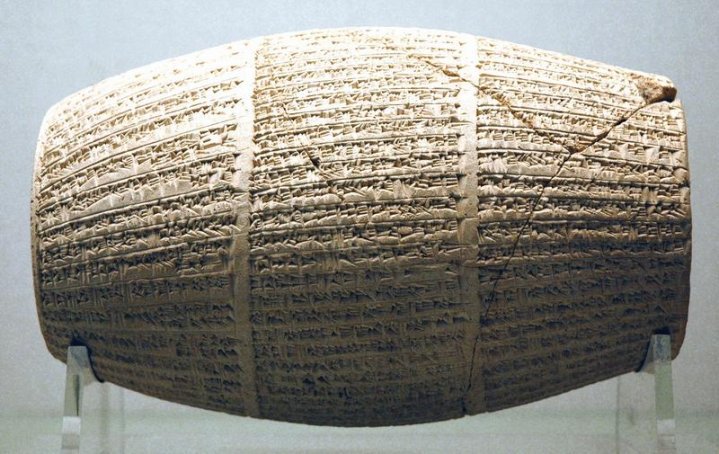إسطوانة نبونائيد
العصر البابلي الحديث، حوالي 555-540 ق.م
سيبار - جنوب العراق
لقد تم إكتشاف الإسطوانة الفخاريّة ذات النقش المسماري في معبد شمش في سيبار. و هي تذكر الأعمال العمرانيّة الورعة التي قام بها نبونائيد "حكم من 555-539 ق.م." لمعابد إله القمر سين في حرّان و معابد إله الشمس شمش و الإلهة أنونيتم في سيبار. و هو يخبرنا بأنّه و خلال العمل في سيبار، تم إكتشاف نقوش الملوك القدماء نارام سين "2254-2218 ق.م. ز شاكاراكي شورياش "1245-1233 ق.م." و قد منح نبونائيد تواريخا تبالغ بصورة كبيرة عمرها
إعتلى نبونائيد العرش بعد إغتيال إثنين من خلفاء نبوخذنصّر، مع ذلك فهو لا يملك صلة قرابة مباشرة مع العائلة الملكيّة البابليّة. و قد كان كبيرا بما فيه الكفاية لأن يحضى بإبن بالغ "بيل-شار- أوصر، بيلشاصر في التوراة" و قد كان تقريبا بصورة مؤكّدة جنديّا متمرّسا. و قد ضمّ عدد من نقوشات نبونائيد مصادرا تاريخيّة في نيّتها إبراز كون إرتقائه العرش بصورة غير منتظمة يحضى ببركات الآلهة و ملوك بابل الأوائل. و فيما له علاقة بموضوع الشرعيّة فإنّ المصادر المتكرّرة لبحث نبونائيد عن مبان قديمة في سلسلة أعماله العمرانيّة الخاصّة
إن جمع وثائق و أشياء قديمة كان قد تمت ممارسته فعلا، على سبيل المثال، في مكتبة آشوربانيبال في قصره في نينوى. و في أطلال القصر الشمالي في بابل وجدت مجموعة من الآثار فيما يشبه متحفا، و يبدو و كأنّها جمعت من قبل نبوخذنصّر الثاني و خلفائه. و قد ظلّ هذا ملاحظا في الفترة الفارسيّة
المتحف البريطاني - لندن
///////////////////////////////////////////////////////////////////////
Cylinder of Nabonidus
Neo-Babylonian, about 555-540 BC
From Sippar, southern Iraq
This clay cuneiform cylinder was discovered in the Temple of Shamash at Sippar. It records the pious reconstruction by Nabonidus (reigned 555-539 BC) of the temples of the moon-god Sin in Harran and of the sun-god Shamash and goddess Anunitum at Sippar. He tells us that during the work at Sippar, inscriptions of older kings Naram-Sin (2254-2218 BC) and Shagaraki-shuriash (1245-1233 BC) were discovered, and Nabonidus offers dates that considerably exaggerate their age.
Nabonidus came to the throne after the assassination of two of the successors of Nebuchadnezzar, even though he had no direct family connection with the Babylonian royal family. He was old enough to have a mature son (Bel-shar-usur, the biblical Belshezzar) and was almost certainly an experienced soldier. A number of Nabonidus' inscriptions include historical references intended to show that his irregular accession to the throne had the blessing of the gods and of earlier Babylonian kings. Linked to this concern for legitimacy are the recurring references to Nabonidus' search for earlier buildings in the course of his own reconstruction work.
Collecting ancient documents and objects was already practised, for example, at Ashurbanipal's library at his palace at Nineveh. In the ruins of the Northern Palace at Babylon a museum-like collection of 'antiquities' was found, apparently collected by Nebuchadnezzar and his successors. This was probably still visible in Persian times.
The British Museum - London
للمزيد الرجاء الأطلاع على // for more please visit
:: سلسلة أثريات ولوحات من بلادي ::







 رد مع اقتباس
رد مع اقتباس
